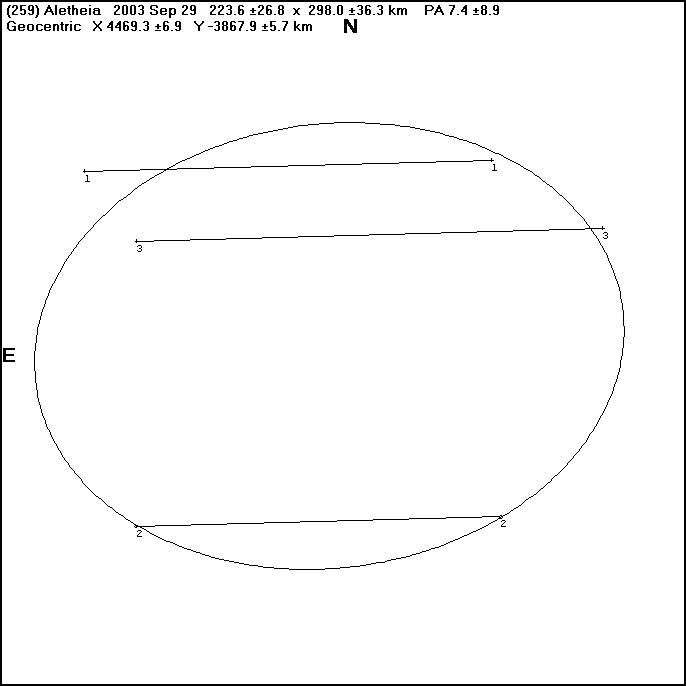CHORDS TO DATE: 3
Chord 1: Alan Gilmore, Mt John, NZ (Photoelectric)
Chord 2: Brian Loader, Darfield, NZ
Chord 3: Euan Mason, West Melton, NZ

OBSERVATIONS AS REPORTED BY THE OBSERVERS:
Observer's Name : Alan Gilmore
Aperture (cm) : 60
Focal length (cm) : 960
Type (e.g. SCT; Newtonian) : Cassegrain
Magnification : N/A (photometer at Cassegrain focus)
Observing site name : Mt John Observatory
Longitude (East +ve) : +170d 27.9'
Latitude (South -ve) : -43d 59.2'
Height above Sealevel (metres) : 1020
Time Source (e.g. WWV, VNG) : See notes
Recording method (e.g. tape) : Photometer computer
Could you see the Asteroid? : ?
Approx. Limiting Magnitude : ?
| Estimated |
Universal Time | Reaction | Accuracy, Remarks
h m s | Time (sec) |
Disappearance At : 12:08:44.6
Reappearance At : 12:08:55.0
Duration : 10.4 sec

ADDITIONAL COMMENTS: Pam and I got the (259) Aletheia occultation in marginal conditions (some cloud, poor seeing) with the single channel photometer on the 0.6 m 'OC' telescope at the University of Canterbury's Mt John Observatory. The measures were made with a Cousins R filter and 47" aperture. In 100ms integrations the counts dropped from ~730 to ~260 counts during the occultation. Problem (again!) with absolute time: With me flashing a torch into the telescope in time to Pam calling the GPS times (_assumed_ to be exactly 2s slow) the computer clock appears to be off by 0.5 second. Due to my not noting a 10th second in the flashes, I don't know whether it was 0.5s fast or 0.5s slow! Again WWVH reception was too poor for an independent check.
Observer's Name : Brian Loader
Aperture (cm) : 25.4
Focal length (cm) : 250
Type (e.g. SCT; Newtonian) : SCT
Magnification : --- Video Observation
Observing site name : Darfield
Longitude (DD MM SS ; East +ve) : +172° 06' 24.4" E
Latitude (DD MM SS ; South -ve) : -43° 28' 52.9" S
Height above Sealevel (metres) : 210
Geodetic Datum (e.g.WGS84,NZ1949): WGS84
Height Datum (if known) : MSL?
Sky Transparency (Delete two) : Good? see comments
Star Image Stability (Delete two): Poor
Time Source (e.g. WWVH, GPS) : GPS/KIWI
Recording method (e.g. tape) : Video tape with LED flash each UT second
Could you see the Asteroid? : No
Approx. Limiting Magnitude : 11 on the video.
| Estimated |
Universal Time | Reaction | Accuracy, Remarks
h m s | Time (sec) |
Started Observing : 11:50
Disappearance At : 12:08:47.7 Reaction time n/a ± 0.5 second
Star and Object Separated : 12:08:57.0 Reaction time n/a ± 0.2 second
Stopped Observing : 12:10
Duration : 9.3 sec
ADDITIONAL COMMENTS: An occultation certainly occurred. It is impossible to get really precise
times from the videotape due to seeing and, presumably, extinction due to lowering altitude,
making the image barely discernable. The times given would have to be given a certainty
rating "2", that is "could be spurious", due to the very poor image.
The star image was just about reasonable half an hour before the event, but deteriorated as
the star got lower. Since Clive Rowe, observing about 11 km to the west, saw the star fade
from view about 3 minutes before the event, due to cloud, it is possible that sky transparency
was getting poorer without my realising it.
Observer's Name : Euan Mason I got a good observation from the R.F. Joyce Observatory using my 8 inch F6 Newtonian at 170x.: 12:8:48.0 UT off 12:8:59.9 UT on Duration: 11.9 sec There was a "winking" sequence of off:on:off lasting perhaps 0.2 sec at the beginning, and exactly the same time for on:off:on at the end. I can't think of an explanation for this, but it was very clear. Can anyone else explain it?
Ashley Pennell (Dunedin): Cloud Paul Rodmell (Invercargill): Lovely evening, collimated, polar aligned, found star OK, set up recorder radio, etc. Nice star until about 11:45 when it started fading. Then couldn't see the brighter stars pointing to the star, then by about 12:00 couldn't see anything out to the south-west. Gave up at 12:09. Went out about 12:30 and the patch of high level cloud seemed to be to the south and it was clear to the south-west. Graham Blow (Martinborough): I drove to a site near Martinborough in the Wairarapa. The sky was largely clear of clouds – excpet in the west around the region of the star. Cloud drifting over the field hampered my identification of the star although I believe I did acquire the correct star just before the occultation time. However even in a C8 it was only visible occasionally using averted vision and it was therefore not possible to unambiguously identify any occultation compared to the random coming and going of the image. Clive Rowe (Waddington) - about 11 km west of Brian Loader: The star faded from view about 3 seconds before the expected time of event. Alan Thomas (Alexandra): Intermittent cloud or fog at Alexandra. Stu Parker (Wyndham) - near Invercargill: Sorry I didnt record a event from here in southland.The seeing was really poor. The star was hard to see. There was also a little haze low on the horzion. Owen Moore (Wellington): Cloud rolled in about 10 minutes before the event.
[Top of Page][Return to Home Page]